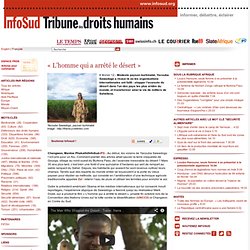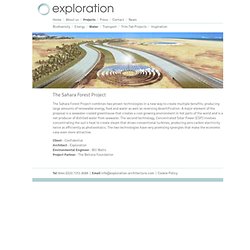

L'homme qui arrêta le désert film entier. Burkina Faso : Yacouba Sawadogo, « l'homme qui a arrêté le désert » Changwon, Mantoe Phakathi/InfoSud-IPS - Au début, les voisins de Yacouba Sawadogo l’ont pris pour un fou.

Comment planter des arbres allait sauver la terre craquelée de Gourga, village au nord-ouest du Burkina Faso, de l’avancée inexorable du désert ? Mais 30 ans plus tard, c’est bien une forêt d’une quinzaine d’hectares qui sert de rempart au sable rampant du Sahel. Depuis, les habitants qui avaient fui sont revenus cultiver leurs champs. Tandis que des experts du monde entier se bousculent à la porte du vieux paysan pour étudier sa méthode, qui consiste en l’amélioration d’une technique agricole traditionnelle appelée Zaï : retenir l’eau de pluie et utiliser les termites pour enrichir le sol. Bande-annonce du film « L’homme qui a arrêté le désert » (en anglais) Plantes médicinale vitales Suivant cette logique, l’agriculteur s’est naturellement préoccupé de l’avancée du désert qui allait engloutir les terres cultivables de Gourga. Droit de propriété contesté. Magnus Larsson: Turning dunes into architecture. Exploration Architecture, Sustainable architecture, Biomimicry, Sustainable architecture inspired by nature, Factor one hundred saving, Sustainability revolution, Michael Pawlyn, Restorative design, The Eden Project, The Eco-Rainforest, Las Palmas Water T.
The Sahara Forest Project combines two proven technologies in a new way to create multiple benefits: producing large amounts of renewable energy, food and water as well as reversing desertification.

A major element of the proposal is a seawater-cooled greenhouse that creates a cool growing environment in hot parts of the world and is a net producer of distilled water from seawater. The second technology, Concentrated Solar Power (CSP) involves concentrating the sun's heat to create steam that drives conventional turbines, producing zero carbon electricity twice as efficiently as photovoltaics. The two technologies have very promising synergies that make the economic case even more attractive.
Client - Confidential Architect - Exploration Environmental Engineer - Bill Watts Project Partner - The Bellona Foundation. Incredible Sahara Forest Project to Generate Fresh Water, Solar Power and Crops in African Desert. Can you imagine being able to produce enough water in the Sahara to grow crops there?

Can you imagine harnessing sufficient quantities of solar power to supply electricity to cities in Africa and cities in Europe? Can you imagine producing a sustainable bio-fuel that doesn't impact on world food supplies? Charlie Paton, Michael Pawlyn and Bill Watts can and what's more they can imagine all these happening in the same place at the same time. This week this trio of visionaries launched the Sahara Forest Project: their proposal to combine two innovative technologies, Concentrated Solar Power (CSP) and Seawater Greenhouses, to produce renewable energy, water and food in an area of desert known to be one of the hottest places on earth.Multitasking renewable solutionsIt has often been said that there will be no one solution to solving the climate crisis and all those issues that surround it, such as energy sources, food prices and water supply.
What does Concentrated Solar Power do? 3. Profile on TED.com. Growing a wall across Africa - Brainiac.